Bitter Gourd Disease Management
Leaf Curl Virus Disease
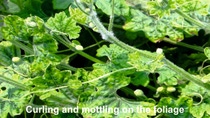
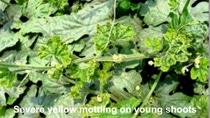
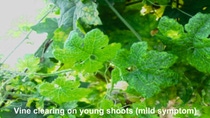.jpg)
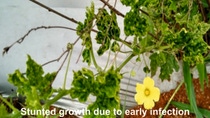
Pathogen:
Common name: Leaf curl virus
Taxonomic position: Viruses: Geminiviridae: Begomovirus
Genus name: Tomato leaf curl New Delhi virus (ToLCNDV)
Tomato leaf curl New Delhi virus (ToLCNDV) is a whitefly-transmitted, begomovirus which was first described on tomatoes in India in 1995. This virus was initially reported on solanaceous crops, but subsequently many reports of damage to cucurbit crops such as: bitter-, sponge-, ridge-, wax-, bottle-, ive-, snake- gourds, cucumber, melon, courgetti and pumpkin.
Identification:
ToLCNDV symptoms in bitter gourd is dependent on the environment, growing conditions, potential mixed infections with other plant viruses, and even the presence of satellite molecules associated with ToLCNDV.
Bitter gourd plants infected at an early stage are severely stunted; their terminal and axillary shoots are erect, and their leaflets are reduced in size and abnormally shaped. Leaves that develop soon after infection are cupped upward, whereas leaves developing later are prominently yellow mottled, chlorotic and deformed, with leaf margins rolled upwards and curling between the veins. The effect on fruits depends on the age of the plant when infected. If infected early, plants lose vigour and stop producing marketable fruits. When infections occur at a later stage of development, additional fruits fail to set, but fruits already present mature in a nearly normal manner. In cases, deformed fruits with change in spine nature can be observed.
Disease Transmission:
ToLCNDV is transmitted by a tiny, sap-sucking insect which around 0.8mm in length and have a snow-white color in adult stage called whitefly (Bemisia tabaci). The dispersal of ToLCNDV is associated with the movement of the whitefly vector. Whiteflies seldom move locally from one to plant to another, and long-distance dispersal may be facilitated by winds and human activities. It is possible that whitefly populations move from one crop to another, particularly when a crop is harvested or abandoned.
Seed transmission of ToLCNDV in bitter gourd has not been reported.
Life Cycle/ Favorable Environmental conditions for the disease/ Monitoring & Thresholds:
The principal habitat for ToLCNDV is cultivated crops and wild plants. Epidemics and outbreaks of ToLCNDV disease are associated with bitter gourd producing regions where environmental conditions are suitable for Bemisia tabaci white flies, such as open fields with moderate to hot temperate.
ToLCNDV disease can be observed in bitter gourd crops throughout the affected regions. The virus is transmitted to cucurbit plants after vector feeding on infected plants or alternative hosts. Disease incidence can vary between seasons and appears to be directly correlated with the pressure of the whitefly population.
Cultural Controls & Prevention:
- The use of genetic resistance appears to be the most promising strategy for control of begomovirus. However, no bitter gourd cultivars with high resistant to ToLCNDV infection have yet been identified. To date, only few hybrids including Nunhems Rushaan have been found to be intermediate resistance by displaying mild symptoms after ToLCNDV infection in later stage, appearing to be potential to control ToLCNDV.
- Specific cultural measured to control ToLCNDV
- Select ideal planting dates in order to avoid periods of high whitefly populations
- Use a floating row cover such as a Vege Net (magic paper) for early-season protection to exclude the whitefly which is responsible for primary virus source.
- Yellow sticky traps to attract the adult whitefly
Powdery Mildew
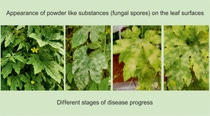
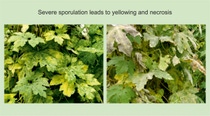
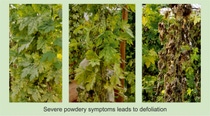
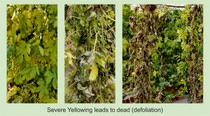
Pathogen:
Podosphaera xanthii
Powdery mildew is one of the major diseases in bitter gourds in all parts of the India. Though it is a major disease, now it is less common due to introduction of powdery mildew resistant hybrid like US 1315 and Rushaan. This disease predominantly prevalent in the cooler spring and early summer months.
Identification:
Symptoms occur on both leaf surfaces, stems, petioles and fruits as white, powdery fungal growth. Symptoms develop first on older leaves, shaded lower leaves, lower leaf surfaces, and on older bearing plants. Infected leaves shrivel and die; plants may senesce prematurely.
Life Cycle/ Favorable Environmental conditions for the disease:
The powdery mildew causing pathogens cannot survive in the absence of living hosts; initial inoculum spreads through winds originating in alternate weed hosts. Other major possible sources include over lapping of older crops in same or adjacent fields. Under favorable conditions, Powdery mildew develops rapidly; the time between infection and symptom expression can be as short as 3 days and many spores are produced. Conditions favoring infection include a dense plant canopy, low intensity light, high nitrogen fertilization, and high relative humidity (although infection can occur at relative humidity of less than 50%). Optimum temperatures for disease development are 20-25°C; infection can occur between 15-30°C. Temperatures of 37°C or above stop Powdery mildew development.
Disease Transmission:
Pathogen spores can be transported from field to field through air currents.
Crop Injury:
Yields are reduced by a reduction in the number and/or size of fruit. Fruit quality can also be adversely affected by sunscald (due to defoliation), incomplete ripening. In addition, infection by Powdery mildew on fruits predisposes fruits to other secondary infection leads to reduced self-life.
Monitoring & Thresholds:
Scout fields regularly (particularly lower leaf surfaces) and apply fungicides early in disease development. Thresholds are very low as Powdery mildew spreads rapidly and cannot be controlled once disease is well established.
Management:
Cultural Controls
- Plant resistant varieties are available: US1315, Rushaan
- Choose planting sites with good air movement and free of shade.
- Unmanaged old crop can become a source of inoculum for new plantings; thus, it is important to remove all old crops actively. If it is not possible, separate the successive plantings physically to prevent older plants from serving as an inoculum source for new crop.
- Powdery mildew develops best on the lower leaf surfaces; thus, a successful fungicide program requires controlling the pathogen on both leaf surfaces. An important component of fungicide programs are materials which can move to the lower surface (systemic or translaminar).
- Powdery mildew cannot be effectively controlled by fungicide applications after the disease is well-established.
